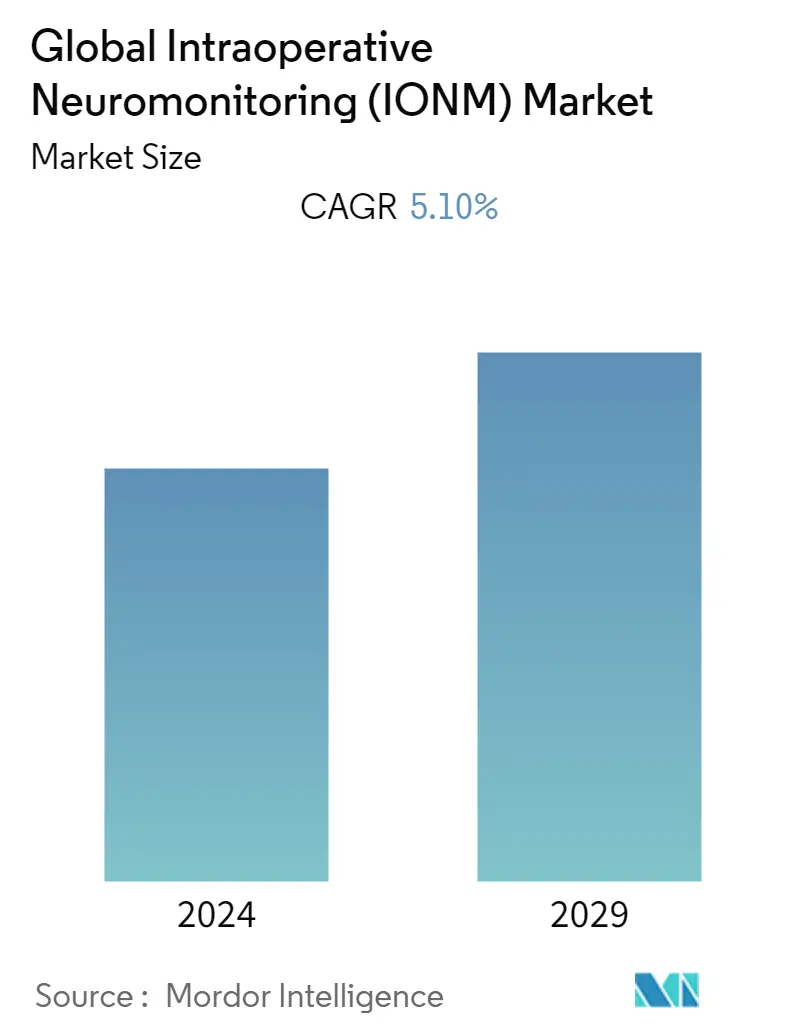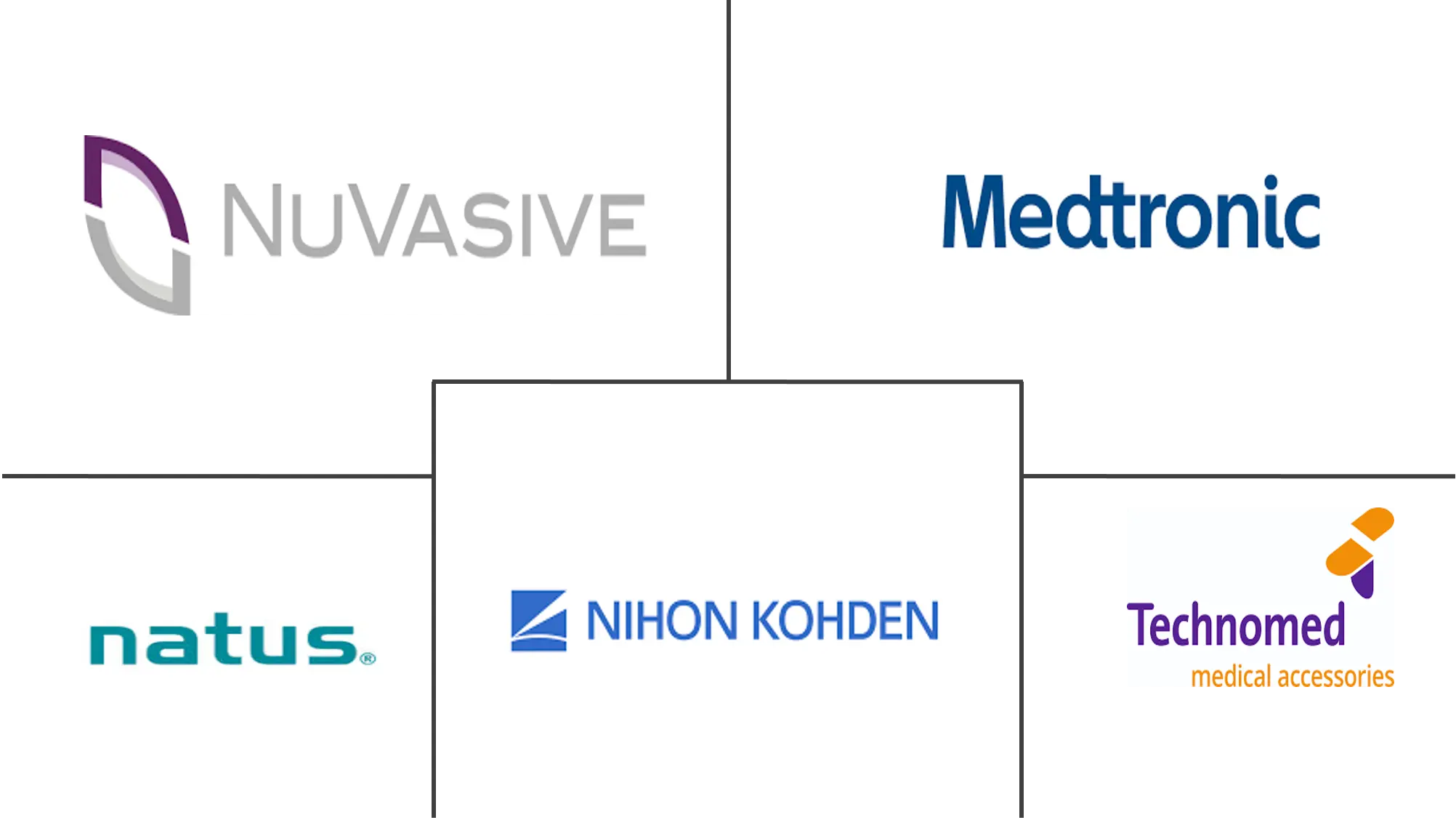Market Size of Global Intraoperative Neuromonitoring (IONM) Industry

| Study Period | 2019 - 2029 |
| Base Year For Estimation | 2023 |
| CAGR | 5.10 % |
| Fastest Growing Market | Asia Pacific |
| Largest Market | North America |
| Market Concentration | Low |
Major Players
*Disclaimer: Major Players sorted in no particular order |
Need a report that reflects how COVID-19 has impacted this market and its growth?
Intraoperative Neuromonitoring Market Analysis
The intraoperative neuromonitoring (IONM) market is projected to expand at a CAGR of 6.5% over the forecast period, 2022-2027.
The COVID-19 pandemic is expected to have a significant impact on the growth of the brain implants market globally, due to the suspension and postponement of most of the elective surgeries and treatment during the pandemic to reserve the hospital infrastructure and staff for treating COVID-19-infected patients. According to a research article published in medRXiV, 2021, titled 'Covid-19 in Parkinson's Disease Treated by Drugs or Brain Stimulation', the prevalence of SARS-COV2 viral infection in patients with Parkinson's disease was found to be 11.28%. Thus, COVID-19 adversely affected the intraoperative neuromonitoring market. Further, COVID-19 prevalence in Parkinson's disease patients with deep brain stimulation was found to be 18.18%. Additionally, according to a research study published by the Frontiers in Neurology in 2020, titled ''Effects of COVID-19 Lockdown on Movement Disorders Patients With Deep Brain Stimulation: A Multicenter Survey", the motor, and psychiatric symptoms in Parkinson's disease patients and dystonic patients treated with deep brain stimulation were observed to have worsened during the lockdown restriction measures, leading to increased stress in the management of neurological disorders.
The growing prevalence of various lifestyles associated with chronic diseases such as neurological and cardiovascular conditions and increasing emphasis on patient safety during complicated surgeries are some of the factors expected to drive the overall market growth. According to the International Diabetes Federation Diabetes Atlas Tenth edition, updated in December 2021, around 537 million adults all over the world were found to have diabetes in 2021; with the numbers projected to grow to 643 million by 2030 and 783 million by 2045. Moreover, as per the Australian Bureau of Statistics released in March 2022, nearly half of Australians of all ages (46.6%) had one or more chronic conditions, and almost one in five (18.6%) had two or more chronic conditions. Almost half (49.0%) of all females had one or more chronic conditions, and one in five (20.7%) had two or more. Similarly, 43.9% of males had one or more chronic conditions and 16.4% had two or more. This will lead to the increased adoption of intraoperative neuromonitoring which has contributed to the growth of this market.
Intraoperative neuromonitoring (IONM) is a critical technique for monitoring neurosurgery as it offers an early warning concerning motor and sensory functions during surgery by reducing intervention time and risk. As per the Centers for Disease Control and Prevention (CDC) updates from March 2021, each year an estimated 1.5 million Americans sustain a traumatic brain injury (TBI). As a consequence of these injuries: 230,000 people are hospitalized and survive. Thus, with the increasing cases of TBI, the adoption of Intraoperative neuromonitoring is expected to increase over the forecast period.
Moreover, the development of advanced devices, such as neurosurgery devices, surgical microscopes, ophthalmic surgical devices, and surgical robots, has led to a reduction in direct human interference in surgical procedures, which is also expected to support the market growth in the near future. For instance, in October 2020, Medtronic plc received 510(k) clearance from the United States Food and Drug Administration for the NIM Vital nerve monitoring system, which allows physicians to detect, monitor, and confirm nerve function, to assist in reducing the risk of nerve damage during head & neck surgeries.
However, the lack of awareness of IONM in underdeveloped nations and the dearth of skilled personnel restrict the market.
